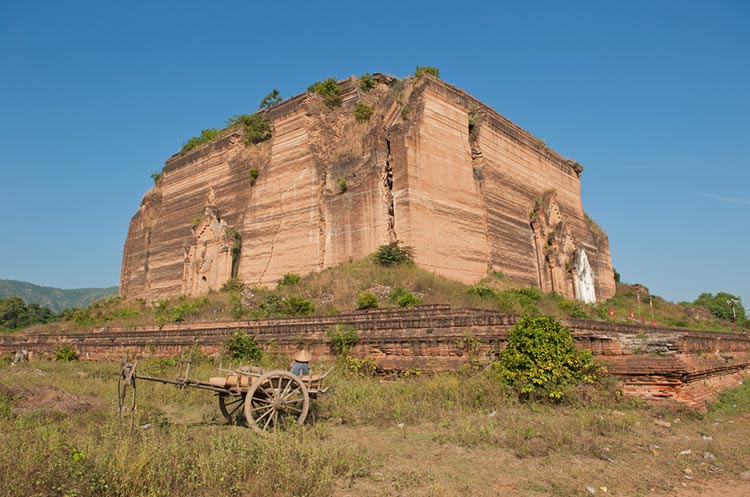
Mingun Pagoda
Massive unfinished pagoda on the Irrawaddy river
The Mingun pagoda is a massive unfinished pagoda built at the end of the 18th century, that was meant to be the largest pagoda in the country.
Giant guardian Cinthe
The massive paya, also known as the Mantara Gyi pagoda, the Mingun Pahtodawgyi and the Great Royal Stupa makes for an impressive site on the banks of the Irrawaddy river. In front of the pagoda facing the river are the remains of two giant Chinthe lions about 29 meters tall, guarding the temple.
At the center of the fifty meter high pagoda facing the river is a huge richly decorated entrance. Inside the pagoda is a small shrine with a Buddha image.
Views from the top
It is possible to climb to the top of the pagoda using a stairway to the right of the structure. From there you will have magnificent views of the area with the nearby Hsinbyume pagoda, several other pagodas, the Irrawaddy river and the mountains to the back of the pagoda.
Two large earthquakes did considerable damage to the Mingun pagoda. During the 1838 earthquake the heads of the giant Chinthes broke off and rolled into the Irrawaddy river. Large cracks appeared in the Paya’s structure.
The Pondaw Pagoda; model of the Great Paya
To get an idea what the pagoda would have looked like if it had been finished, have a look at the Pondaw pagoda. This whitewashed pagoda with a golden spiral on top nearby at the bank of the river is a model of what the Great Paya was meant to be. A grand stairway guarded by two Chinthes gives access to the five meter high model.
On the streets behind the Mingun Paya are a few souvenir shops and restaurants.
History of the Mingun Pagoda
Construction of the massive pagoda was ordered by King Bodawpaya, the 6th King of the Konbaung dynasty. The King who was at the peak of his power achieved a number of great successes at the end of the 18th century.
In 1784 he invaded Arakan and seized the capital city Mrauk U. Among with other treasures, he seized the Mahamuni Buddha image, Burma’s most highly venerated Buddha image and brought it back to his Kingdom.
He also acquired a sacred Buddha tooth relic, something that his predecessors had not been able to achieve. To enshrine a Buddha relic of such great importance, the King wanted to build the largest pagoda in the country and probably in the world. The King intended the pagoda to be 152 meters high. The impressive scale of the Paya was probably also meant to serve as a demonstration of his power.
The pagoda was of such great importance to the King that he left the matters of state to his son and had a new residence for himself built on an island in the river to oversee the construction project.
Construction of the Pagoda halted in 1797
Work on the pagoda started in 1790. In 1797 when the pagoda had reached a height of 50 meters, one third of the intended height, construction was halted. There were probably several reasons why work on the project stopped.
Because of the massive size of the pagoda that was meant to be much larger than anything else in its time, it is likely that there were technical difficulties with the construction.
Another problem was insufficient labor, because many of the slaves brought over for the construction project escaped.
A prophecy going around in the Kingdom foretold that once the pagoda was finished the Kingdom would come to an end, which may have led to a deliberate slowdown of the project. It is also likely that there was insufficient funding to complete the pagoda, because of economic problems at the turn of the century.
When the King died in 1819 the project was indefinitely halted and none of his successors resumed work on it.
The Mingun bell
In 1808 King Bodawpaya had an enormous bell made that was meant to be installed at the top of the giant stupa. The bell is housed nearby the Paya in a Zayat, an intricate Burmese style pavilion with a multi tiered roof. The bell that was cast from 1808 until 1810 measuring almost 4 meters high is the largest working bell in the world. The number 55555 is inscribed in Burmese script on the outside of the bell, 55555 being the weight in viss, a Burmese unit of measurement, which is about 90 tons. The bell is rung by striking its exterior with a wood log.
How to get to the Mingun Pagoda
The Paya is located on the West bank of the Irrawaddy river in the North part of Mingun town. The Mingun bell is a few hundred meters North of the pagoda. The site is about ten kilometers from Mandalay.
The easiest and most fun to get there is by boat from Mandalay which takes around one hour. From the pier you can either walk to the Paya or take an ox cart marked as taxi. The Paya is a Buddhist temple, please take off shoes and socks before entering.
Opening hours
The pagoda opens daily during daylight hours.
Entrance fee
A ticket for the Sagaing - Mingun archaeological zone costs US$ 4. This ticket is valid for the Mingun pagoda and for other monuments in the area like the nearby Hsinbyume pagoda.